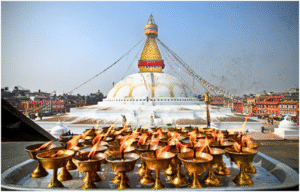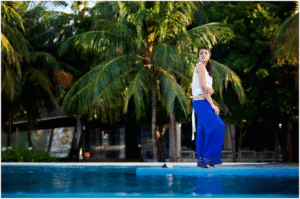
Exploring Nepal’s Hidden Gems: From Langtang Valleys to Everest Peaks and Mustang Deserts:
Nepal is more than fair a country—it’s a tremendous and dynamic canvas of the Himalayas, wealthy with tall peaks, antiquated societies, and wild scenes. Whereas most travelers arrive in look of Everest and Annapurna, Nepal’s covered up pearls extend distant past its well known trails. From the frosty magnificence of Langtang Valley to the all encompassing vistas of the Everest view trek, from the world-famous Everest Base Camp trek to the secretive Tibetan forsake of Upper Mustang, this different country offers an extraordinary mix of nature, culture, and experience. This article takes you on a trek over Nepal’s most captivating, however frequently underrated, destinations—where each step interfaces you with breathtaking sights, otherworldly profundity, and the warm neighborliness of mountain people.
Langtang Valley trek:
Tucked in a far north of the capital city, the Langtang Valley trek offers a shockingly open enterprise into one of Nepal’s most picturesque elevated regions. Frequently dominated by the Annapurna and Everest regions, Langtang remains a calmer, less-traveled jewel—ideal for trekkers looking for isolation, genuineness, and untainted beauty.
The travel starts with a drive from Kathmandu to Syabrubesi, taken after by a few days of trekking through lavish woodlands, cascading waterfalls, and conventional Tamang and Tibetan-influenced towns. As you climb the Langtang Stream Valley, the discussion turns fresh and the view moves to sensational frigid scenes, snow-capped peaks, and tall pastures. The highlight of the trek is Kyanjin Gompa, a peaceful elevated town encompassed by towering mountains like Langtang Lirung (7,234m).
From Kyanjin, trekkers can climb up to Kyanjin Ri or Tserko Ri for all encompassing views of the whole Langtang extend. The otherworldly climate of the ancient cloister, the inviting nature of nearby tea houses, and the incidental location of Himalayan natural life like ruddy pandas and yaks add to the valley’s calm charm.
Despite its vicinity to Kathmandu, Langtang offers a genuinely off-the-beaten-path involvement. After the 2015 seismic tremor, the region has revamped with flexibility, and tourism here presently underpins imperative recuperation and vocation endeavors. It’s the culminating trek for those who need a sensational view without the overwhelming crowds.
Everest view trek:
If you need to encounter the enchantment of Everest without committing to a strenuous high-altitude trek, the Everest view trek is a culminating elective. Outlined for consolation and available experience, this trek offers marvelous Himalayan scenes, dynamic Sherpa culture, and world-class hospitality—all in beneath ten days.
The trek starts with a picturesque flight or helicopter ride from Kathmandu to Lukla, the portal to the Khumbu region. From there, you pass through beautiful towns like Phakding and Monjo, at last coming to the famous Sherpa town of Namche Bazaar. Here, settled on a horseshoe-shaped mountain edge, the seas open up to monsters like Thamserku, Kongde Ri, and of course, the amazing Mount Everest itself.
The crown gem of the trek is the climb to Inn Everest view, one of the world’s highest-altitude extravagance inns. Set at 3,880 meters, the inn offers 360-degree views of Everest and its neighboring peaks right from your breakfast table. Acclimatization climbs to Khumjung town, tours to antiquated religious communities, and interaction with nearby Sherpa families make this brief trek an important social and beautiful trek.
What makes the Everest view trek extraordinary is its consolation and inclusivity. You don’t require to be a master explorer or spend weeks in the mountains. With comfortable lodges, great nourishment, and well-paced agendas, indeed families or more seasoned travelers can appreciate the glory of the Everest region without the physical requests of the full Everest Base Camp trek.
Everest Base Camp trek:
Few encounters in life compare to the sheer excitement and fulfillment of standing at the base of the world’s tallest mountain. The Everest Base Camp trek is not a fair hike—it’s a trek into the heart of the Himalayas, a test of perseverance, and a passionate trek through a few of the most awe-inspiring landscapes on Earth.
This notorious trek starts in Lukla and takes after the Dudh Koshi waterway valley through lavish pine woodlands, hanging suspension bridges, and dynamic Sherpa settlements. Each day brings you closer to the powerful peaks, with stops at Namche Bazaar, Tengboche Cloister, Dingboche, and Lobuche, some time recently at last coming to Gorak Shep and the popular Everest Base Camp (5,364m).
Along the way, trekkers are treated to an ever-evolving canvas of snow-draped mountains, counting Ama Dablam, Lhotse, Nuptse, and of course, Everest (8,848.86m). A morning climb to Kala Patthar (5,545m) offers the best close-up view of Everest itself, enlightened in brilliant morning light.
But the trek isn’t about mountains—it’s about association. You’ll meet individual trekkers from around the world, share stories over tea, and learn approximately Sherpa life and Buddhist most profound sense of being. The high-altitude religious communities, supplication banners vacillating over ridgelines, and turning supplication wheels include a supernatural quality to the trek.
Though challenging, the Everest Base Camp trek is profoundly fulfilling. For those looking for included consolation, choices like watchman administrations, overhauled teahouses, or indeed a helicopter return from base camp are accessible. EBC is more than a bucket list item—it’s a once-in-a-lifetime change that lowers and inspires.
Upper Mustang Jeep tour:
In stark difference to Nepal’s snow capped scenes is the enchanted forsaken kingdom of Upper Mustang, an arrival so far and socially particular that it feels like venturing into another world. Once closed to nonnatives and still requiring uncommon grants, Upper Mustang is frequently alluded to as the “Last Taboo Kingdom.” Not at all like conventional treks, the Upper Mustang Jeep tour gives a more available way to investigate this surprising region without days of strenuous hiking.
The travel starts in Pokhara, from where you either fly or drive to Jomsom, the door to Mustang. From here, a 4WD jeep enterprise starts, climbing through the Kali Gandaki gorge—the world’s most profound canyon—into a strange scene of wind-carved cliffs, ruddy shake arrangements, and caves utilized by Buddhist ministers for meditation.
The course winds through antiquated Tibetan-style towns like Kagbeni, Chhusang, and Ghami, in the long run coming to the capital of Lo Manthang, a walled city straight out of a medieval epic. Lo Manthang is domestic to whitewashed royal residences, overly complex rear ways, centuries-old religious communities, and dynamic supplication ceremonies. Neighborhood conventions, clothing, and dialect here are more Tibetan than Nepali, advertising an uncommon window into a vanishing way of life.
One of the major highlights is the tour to Chooser Cave, a multi-story cliffside complex once utilized by ministers for centuries of contemplation. The jeep tour incorporates stops at all encompassing perspectives, experiences with migrant herders, and openings to involve neighborhood neighborliness in conventional guesthouses.
Unlike tough trekking courses, the Upper Mustang Jeep tour offers enterprise with relative ease. You can cover incredible separations whilst still drenching yourself in the culture, history, and stark magnificence of this high-altitude leave. It’s a must for those who need secret, myth, and off-the-beaten-track exploration.
Nepal’s Mosaic of Differences: Why These Treks Matter
Each of these treks and tours—Langtang Valley, Everest view, Everest Base Camp, and Upper Mustang—presents a distinctive feature of Nepal. Langtang is lavish and otherworldly, Everest view is beautiful and lavish, Everest Base Camp is famous and transformative, and Upper Mustang is enchanted and remote.
What joins them together is the true association they offer—to nature, to nearby culture, and to oneself. These ventures are not fair around coming to goals but almost encountering moments—sharing tea with a yak herder, observing friars chant in a mountaintop cloister, or looking at Everest beneath starlight. Whether you’re strolling or riding in a jeep, extravagance or essential, tall elevation or lower, Nepal gives you a space to reflect, revive, and reawaken.
For enterprise searchers, picture takers, social devotees, or first-time trekkers, this assortment implies Nepal can be experienced once more and once more, each time through a diverse lens.
Planning Tips for Investigating Nepal’s Covered up Gems
Best Time to Travel: The best months for all these courses are spring (March to May) and harvest time (September to November). The climate is clear, dry, and perfect for mountain views and secure travel.
Permits: Langtang requires TIMS and Langtang National park licenses. Everest courses require Sagarmatha National park grants and Khumbu Pasang Lhamu Provincial Region licenses. Upper Mustang requires limited range licenses (~$500 for 10 days) and ACAP entry.
Fitness Level: Langtang and Everest view are direct; EBC requires great wellness and acclimatization; Mustang by means of jeep is low-impact and reasonable for all ages.
Packing Fundamentals: Quality trekking boots, warm layers, sun assurance, water filtration, elevation pharmaceutical (in the event that required), and a dependable backpack.
Accommodation: Langtang and EBC offer fundamental to updated teahouses. Everest view trek incorporates extravagant lodges. Upper Mustang jeep tours utilize comfortable guesthouses or boutique hotels.
Guides and Security: Contracting an authorized guide and watchman is exceedingly prescribed for route, security, and social understanding. Climate, elevation, and landscape can be challenging.
Conclusion:
Nepal is an arrival that resists definition. In one trip, you can navigate rich valleys, walk among the world’s most elevated mountains, and investigate old Tibetan desserts. These covered gems—Langtang, Everest view, Everest Base Camp, and Upper Mustang—offer more than fair excellent trails. They offer stories, souls, and stillness that wait long after the travel ends.
Whether you’re chasing the excitement of tall peaks, the peace of inaccessible valleys, or the echoes of overlooked kingdoms, Nepal welcomes you to investigate profoundly, travel gradually, and interface definitively. Each trek is a portal, and behind it lies a world holding up to be discovered.
Contact to Escape Himalaya
You Can contact Escape Himalaya by using our email address info@escapehimalaya.com We are available at any time. Escape Himalaya will deliver you price-worthy services, professional guides, trained staff, and assistance on every trip.


